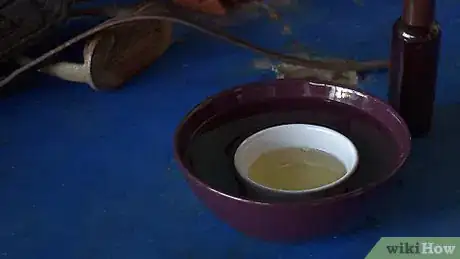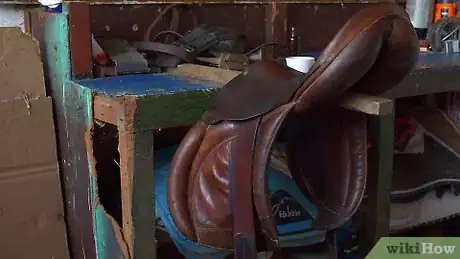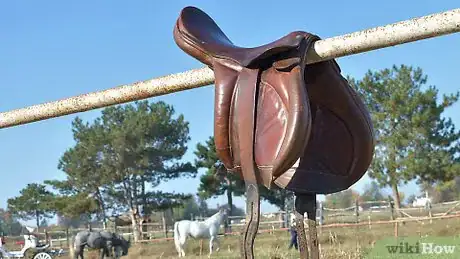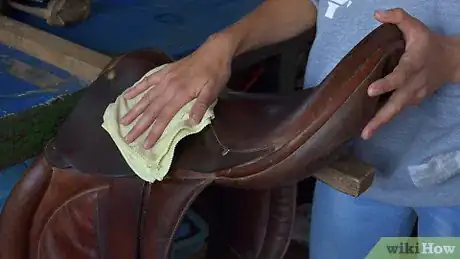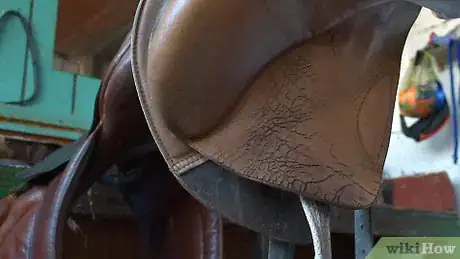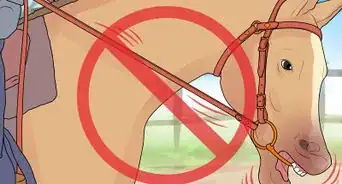This article was co-authored by Ryan Corrigan, LVT, VTS-EVN. Ryan Corrigan is a Licensed Veterinary Technician in California. She received her Bachelor of Science in Veterinary Technology from Purdue University in 2010. She is also a Member of the Academy of Equine Veterinary Nursing Technicians since 2011.
This article has been viewed 45,999 times.
In order to properly maintain your leather saddle, you may occasionally need to oil it. Depending on the saddle, the climate, and how often you ride, you may need to oil your saddle every few months to a year. However, some saddles do not need to be oiled and can be ruined by being over conditioned. Be sure to follow the manufacturer’s recommendations to avoid damaging your saddle. Besides providing the occasional oiling, you will also need to clean the saddle regularly and follow some simple rules of thumb to keep it properly maintained. Oiling, cleaning, and properly maintaining your saddle will help prevent unnecessary wear and tear and keep you safe while riding.
Steps
Oiling a Leather Saddle
-
1Warm the oil. Before you begin oiling your saddle, be sure to warm your oil. The oil needs to be warm (at most 100 degrees Fahrenheit or 38 degrees Celsius), but not hot. Hot oil can cook your leather and ruin it. In order to guarantee that it’s the right temperature, try soaking it in lukewarm water for about 20 minutes.
-
2Apply the oil. Once you have properly cleaned your saddle, gently apply a light coat of oil to the grain (smooth or outward facing) side of the saddle. You can use a brush or a rag to very lightly apply the oil. Do not let the oil pool or build up on the leather. This will oversaturate it and ruin the leather.Advertisement
-
3Rub in the oil. Use a rag or tack sponge to apply oil to the saddle. Be sure to use a circular motion to get an even application. This will help you avoid spotting. You can also use your hand to apply the oil if you find some hard to reach places.
- Avoid applying oil to the flesh side or any rawhide parts of the saddle. This will cause them to loosen and stretch out.
- Instead of rubbing it with oil, soak your bridle in a shallow pan full of oil.
-
4Let the saddle sit. Once you have covered the grain in oil, let it sit for a day or two. This will allow the oil to soak into the leather. Keep the saddle in a dry and climate controlled location. Avoid placing it in direct sunlight.
- If you are oiling the saddle for the first time, you may want to let it sit for longer.
-
5Wipe off excess oil. After the saddle has sat for a couple days, take a rag and wipe off any excess oil. You should also use a rag to buff the saddle as you wipe off the excess, rubbing in a circular motion. This will help prevent any spotting or discoloration in the leather.
- Avoid using the saddle again until it is completely dry.
-
6Repeat the process. If you are oiling your saddle for the first time, you may need to condition it at least three times over the course of a couple of weeks. You may want to pay particular attention to the fenders and the seat, which will need a little help loosening up.
- Be sure to follow the manufacturer’s guidelines when oiling your saddle. Over conditioning the saddle can make it too loose and ruin it.
- Because they are used regularly, you may want to apply more oil to the fenders.
- The seat may need some extra oil to make it form to your bottom.
-
7Apply a conditioner. After the saddle is properly oiled, you may want to rub in a little conditioner. This will help treat the leather and prevent it from drying out. Simply apply a small amount of conditioner to a rag and gently rub it into the leather. Be sure to use a commercial leather conditioner that is appropriate for your saddle. Your local western ware store should have saddle conditioner.[3]
- Conditioner is particularly important if you live in an arid climate where your saddle can get dried out.
- Be sure to follow the saddle manufacturer’s guidelines before applying any conditioner to your saddle.
Cleaning a Saddle Before Oiling
-
1Place the saddle on a stand. In order to give your saddle a proper cleaning, you will want to set it on something that will allow you to freely move around it. Ideally, this would be a saddle stand. A stand will give you a sturdy base to work from and help you reach difficult to clean areas. It will also ensure that the saddle maintains its natural position and does not pool water or soap while you clean it.
- Avoid laying it on a table or on the ground. This will bunch up the saddle and make it difficult to clean properly. It will also get dirty on the ground, and defeat the purpose of the entire process.
- Do not clean your saddle while it is on your horse. This may irritate your horse.
-
2Remove all attachments. Before you begin cleaning your saddle, you will want to remove any attachments. These include the stirrups, breast collar, and cinches. You will want to be sure to remove any rawhide attachments, which can soak up excess water and get ruined.
- If you are conditioning any attachments, do not let them soak in oil while you clean and condition the saddle. This will ruin them. Lightly rub them with oil when you oil the saddle.
-
3Wipe off dust and dirt. Use a dry cloth or brush to wipe off any dust or clumps of dirt. This step is particularly important because you will use very little water when you wash the saddle and removing any dirt beforehand will require less scrubbing. Excess scrubbing and water exposure will damage your leather.
-
4Wash the saddle. Mix your preferred saddle soap with as little water as possible. The water should be lukewarm (around 100 degrees Fahrenheit or 38 degrees Celsius) and mixed with the soap to create a thick foamy lather. Use a double-sided kitchen sponge or loofah glove to gently scrub both sides of the saddle. Be sure to thoroughly scrub the sections that come into contact with the horse - the backside of the fenders, stirrup leathers, and cinch straps.
- Check your manufacturer’s recommendations on saddle soaps or pastes.
-
5Rinse the leather. Use a clean rag or sponge and a fresh bucket of warm water to rinse off the saddle. Gently wipe off the soapy residue, making sure to rinse your rag regularly. You will want to be sure to remove all of the soap from the saddle but not use too much soap when doing it.
- Avoid spraying down your saddle. This will soak it with water and possibly ruin the leather.
-
6Dry the saddle. Once you have removed all soap residues, let the saddle dry in the air. You may also want to use a towel to remove any excess water. Be sure to store the saddle in a dry place. However, do not leave it in the sun or under direct heat. You want it to be dry but still cool to the touch.
- Your saddle should be completely dry before oiling. Oiling moist leather may oversaturate the leather and cause it to stretch.
Maintaining Your Saddle
-
1Wipe down your saddle often. Ideally, you will want to wipe down your saddle with a damp cloth after each ride. This will remove any dirt, sweat and other materials that can make your saddle dirty. Cleaning your saddle after each ride will limit how often you have to give your saddle a thorough scrubbing.[4]
- Wiping your saddle after each ride will also help you spot any problems with wear and tear, like loose stitching.
-
2Condition and oil your saddle regularly. Properly cleaning and conditioning your saddle will help extend its life. If you occasionally ride, you may not need to condition and oil your saddle for around six months. If you live in an extremely dry or humid location, you may need to condition more frequently.[5] Some saddles do not need to be conditioned at all.[6]
- Be sure to follow your manufacturer’s guidelines for conditioning and oiling your saddle.
-
3Store saddles properly. When not in use, the ideal place to keep a saddle is in a climate controlled area. This will help keep the saddle from getting too wet or dry. If a climate controlled location is not available, keep the saddle in a cool and dry location.[7]
- If you are storing a saddle for an extended period of time, make sure that it is cleaned and oiled beforehand.
- Do not stack saddles on top of each other.
- Never place a saddle in direct sunlight or expose it to heat.
- Never store a saddle in a plastic bag or any airtight container. This will prevent the leather from breathing and ruin it.
- If your saddle came with a cover, place it over the saddle when it’s not being ridden to prevent dust accumulation and animal damage.
-
4Replace any cracked leather. If any part of your saddle has cracked, do not try to oil or condition it. The cracked part is ruined and cannot be salvaged. Riding with cracked leather could result in an accident. Have a professional replace any worn or cracked pieces of your saddle.[8]
- Check your saddle every time you ride. Pay close attention to the rigging, fenders, stirrup leathers, and latigo tie straps.
Warnings
- Keep in mind that oiling your saddle can darken the color of the leather permanently.⧼thumbs_response⧽
References
- ↑ http://www.trumbullmtn.com/saddle-fitting/your-new-saddle-care-and-feeding/
- ↑ http://www.trumbullmtn.com/saddle-fitting/your-new-saddle-care-and-feeding/
- ↑ http://info.farnamhorse.com/Stable_Talk/Entry/proper_saddle_cleaning
- ↑ http://www.trumbullmtn.com/saddle-fitting/your-new-saddle-care-and-feeding/
- ↑ http://info.farnamhorse.com/Stable_Talk/Entry/proper_saddle_cleaning
- ↑ http://www.trumbullmtn.com/saddle-fitting/your-new-saddle-care-and-feeding/
- ↑ http://info.farnamhorse.com/Stable_Talk/Entry/proper_saddle_cleaning
- ↑ http://info.farnamhorse.com/Stable_Talk/Entry/proper_saddle_cleaning
About This Article
To oil a leather saddle, start by removing the attachments and cleaning the surface thoroughly. Next, heat the oil gently so that it's warm but not hot. Then, use a brush or a rag to apply a light coat of oil to the smooth or outward-facing side of the saddle using circular motions. Finally, place the saddle somewhere dry and out of direct sunlight for 1-2 days so the leather can soak up the oil. After a couple of days, buff the surface of the saddle with a clean rag to get rid of any excess oil. To learn more about cleaning your saddle properly before oiling it, read on!
